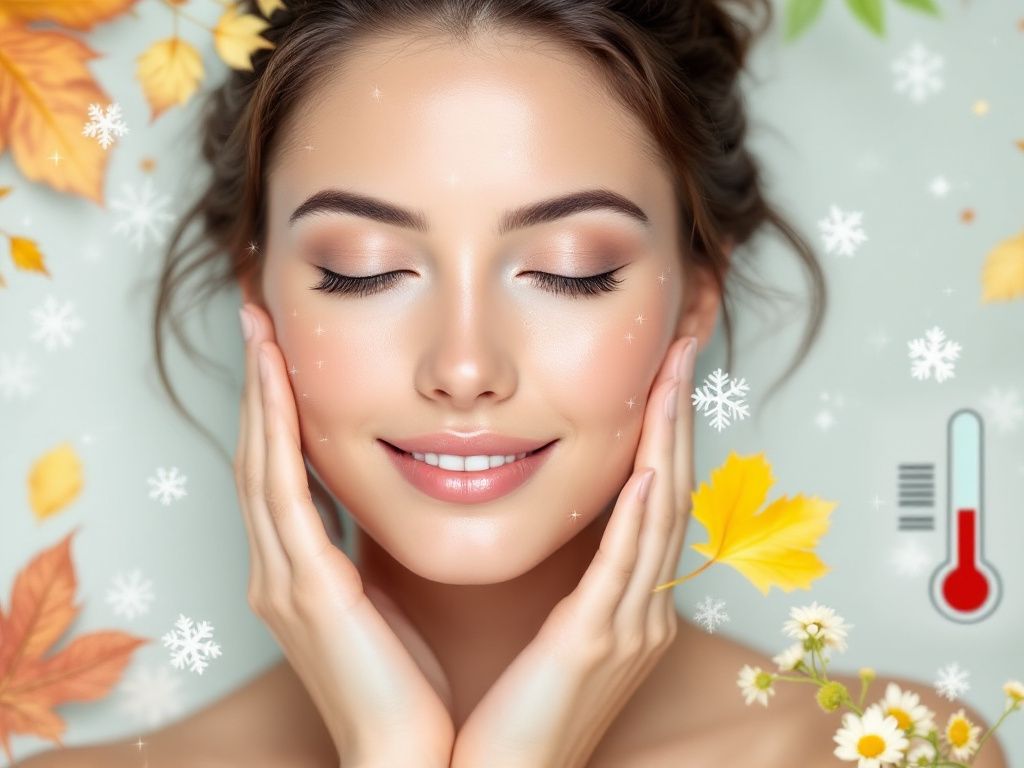Ever wake up one day and your skin feels… different? Perhaps yesterday it was happy and hydrated, but today’s tale is more of a dry, chapped one. If you’ve been bouncing between lotions and potions only to feel like your skin’s thermostat has a mind of its own, then welcome aboard. You’re not alone, and boy, do we have some things to chat about!
First things first—temperature change is a tricky player in the seasonal skin game. Just as fashionistas swap their cottons for wools with zeal, our skin demands its own form of seasonal wardrobe adaptation. And with each season playing its unique hand in this skin-decked poker game, keeping your epidermis happy is about adapting and pivoting smartly when these temperature swings come a-knocking.
Why Temperature Change Messes with Your Skin
Let’s get cozy with the concept of moisture. When the temperature drops like it’s hot (or not), moisture in the skin becomes a wanted fugitive. Cold air zaps the humidity, which essentially acts like a natural skin moisturizer, right outta the skies. What happens next? Your skin gets cranky and dry.
On the flip side, when things are heating up, it’s sweat and more sweat. Warm weather means oil glands might decide to throw a party, making your face roomier for pores and breakouts. It’s a delicate balance where keeping that much-needed hydration can become a full-time job.
The Upside of Seasonal Skin Awareness
Before this turns into a melodrama, here’s the good news: a little knowledge goes a long way. Embracing seasonal skin care ensures that you pivot nimbly like a cat on a hot tin roof. And it allows you to reach that sweet spot of moisturization, where your skin feels as great as it looks. Trust us on this one—being proactive about temperature changes is like giving your skin a protective wellness plan all year long.
Humidity: The Unsung Hero of Skin Protection
Imagine you’re in a humidity cocoon (an admittedly sticky cocoon, to be fair). Seasonal shifts in temperature can mercilessly strip moisture levels. Density in the air helps your skin stay hydrated, which is why a balance in humidity levels can maintain suppleness and smoothness even on the coldest of days.
**Case in Point:** If humidity levels stay between 30-50%, your skin will maintain a neutral thriving zone. Anything below or beyond this sweet spot becomes a recipe for dry or excessively oily skin. So, as temperatures play a game of tag, it’s worthwhile keeping humidity on your radar.

Getting Hands-On: Steps to Navigating Temperature-Sensitive Skincare
Let’s break this down the DIY way, where you transform yourself into a bonafide temperature-care aficionado. No rocket science here, just a bit of good ol’ skin sense with a sprinkle of consistency.
1. Know Your Seasonal Enemies
– **Winter:** Cold, dry air loves leeching moisture. Itchy, flaky skin becomes a common grievance. – **Summer:** Heat means more oil and sweat. Cue shiny nose syndrome and clogged pores. – **Spring/Fall:** Transitional temps mean your skin can flip from oily to dry pretty unpredictably.
2. Modify Your Cleansing Ritual
Here’s a thought: swap those heavy-duty cleansers for gentler ones in winter. Embrace milder, moisturizing cleansers and avoid over-cleansing, which can strip the skin of essential oils.
**Summer Flip:** Bring back the slightly more robust cleansers to manage excess oil production. Don’t shy away from double cleansing if you’ve been out and about.
3. Moisturization: The Holy Grail
– Double down on moisture levels in winter. Opt for a hydrating serum smothered by a rich, creamy moisturizer. – In summer, a lighter touch is wiser. You might enjoy the ease of a hydrating gel or oil-free product to prevent excess buildup or sheen.
Tip: Pay Attention to Ingredients
– For colder months, ingredients like hyaluronic acid and glycerin proudly hold the fort. – In warmer months, aloe and tea tree oil keep you cool as cucumbers with antibacterial goodness.
4. Sunscreen All Year Round

– Sun protection is a non-negotiable hero in every climate. Yes, even when it’s glacially cold and grey outside.
5. Be Water Wise
Drink up! Hydrating internally is just as vital. Not only does it combat dryness, but it also helps maintain the skin’s metabolism, which means you’re getting the rejuvenation party started from the inside out.
Diving Into Adaptation: Creating Flexibility
Now this isn’t set-it-and-forget-it territory. It’s fluid. Stay in tune with your skin’s needs—they’re valid. And sometimes even micro-adjustments can make bankable differences.
Seasonal Skin Journaling
Yeah, it sounds geeky, but jotting down how your skin behaves through different seasons is savvier than you’d think. Over time, you’ll start to notice patterns, allowing you to proactively adjust your routine.
Tech Time: Humidifier Supplements
Here’s one to ponder: If humidity’s being a slippery operative in your locale, consider investing in a humidifier to balance that indoor dryness. It’s like having a climate controller right in your living room—who wouldn’t love that?
Check-In with a Dermatologist
For persistent issues, regardless of season-tailoring strategy, seeking expert advice makes a world of difference. Ideally, a dermatologist helps in personalizing product choices and provides quick fixes if your skin throws a right hook anyway.

Clarifying Common Mistakes
We get it. Perfection is a myth—but let’s sidestep classic temperature care follies.
Mistake #1: Ignoring Lip & Hand Care
– Lips and hands need TLC too. They’re the first casualties in the cold or when temperature tolerances go haywire. Keep easygoing balms on the ready to pucker up beautifully and avoid ashy palms.
Mistake #2: Dense Cosmetic Layers
– Layering cosmetic products too thick during active seasonal phases is like asking for trouble. Keep it airy, breathable, and allow skin some good ol’ space to ‘breathe.’
Mistake #3: Overswitching Products
– Jumping jagged is like skin suicide if you change products faster than the seasons shift. Honor your skin’s learning curve and don’t force abrupt changes without giving your skin transition room.
Seasonal Skin Care Ethos: Make Protection a Constant Companion
One part art, one part science, the temperature care dance harmonizes well when we remember the basics. Watch. Adapt. Protect.
Finding clarity from season to season with intentional care is a wild blessing for naturally luminous skin. Get comfortable pivoting through tailored routines, remain nourished top-down, and keep environmental shifts under a caring view.
So, if your skin seems bipolar at times, no sweat. You’ve got this figured out with a strong plan to help it thrive every season. Adaptation is key. Protection is king. Enjoy the transition flight. 🌞🌧️❄️
Frequently Asked Questions
What is seasonal skin tone?
Seasonal skin tone, also known as seasonal colors, refers to the categorization of skin tones into four seasons (Winter, Spring, Summer, and Fall) based on their undertones and how they interact with different colors. This helps in choosing the most flattering colors for clothing, makeup, and other aesthetic choices[1][5].
How do I determine my seasonal skin tone?
To determine your seasonal skin tone, first identify whether your skin has cool or warm undertones. Look at your forearm in natural daylight; if the undertones are pink or blue and your veins appear bluish, you have a cool skin tone. If you see yellow undertones with greener veins, you have a warm skin tone. Then, match your skin tone with your hair and eye color to determine which season you fall into (Winter, Spring, Summer, or Fall)[1][5].
What colors should I wear based on my seasonal skin tone?
The colors you should wear vary by season: – **Winter**: Rich colors like blue, red, and hot pink. Avoid neutral and earthy tones. – **Spring**: Pale, clear, and bright colors. Avoid dark colors and black and white. – **Summer**: Pastel, muted, and neutral tones. Avoid bright colors. – **Fall**: Earthy and rich colors. Avoid pastels and bright colors[1][5].
Is seasonal skin tone related to the actual changing of the seasons?
No, seasonal skin tone does not refer to the actual changing of the seasons. It is a system used to categorize skin tones and recommend colors that are most flattering based on those tones, regardless of the time of year[1][5].
References










